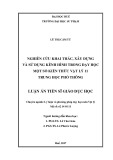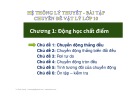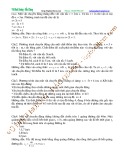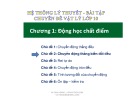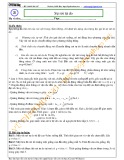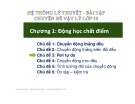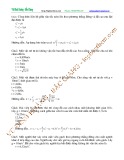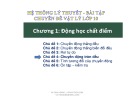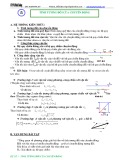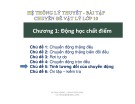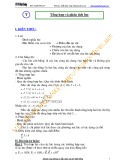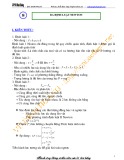Journal of Physical Science, Vol. 18(1), 11–21, 2007 11
PREPARATION OF SELENIUM-DOPED ACTIVATED CARBON AND ITS UTILIZATION FOR IMPROVING THE QUALITY OF USED COCONUT OIL
E. Kusrini*, A. Setyopratiwi and U.M. Yahya Faculty of Mathematic and Natural Sciences, Gadjah Mada University, Sekip Utara, BLS 21, Yogyakarta, 55281 Indonesia *Corresponding author: eny2kus@yahoo.com Present address: School of Chemical Sciences, Universiti Sains Malaysia, 11800 USM Pulau Pinang, Malaysia
INTRODUCTION
Abstract: Activated carbon (AC) doped with Selenium (Se) element (2.5% w/w) was prepared by calcination, oxidization and reduction processes. The modified activated carbon (MAC) material exhibited specific surface area and total pore volume of 889.43 m2/g and 486.35 cc/g.10–3, respectively, and these are higher than ordinary AC. The pore size determination showed a distribution of 63.88% mesopore and 36.12% micropore. Several key quality indicators of the oil were determined for the used coconut oil before and after being treated with the MAC and these were compared to those of fresh coconut oil. The prepared MAC shows promise as an effective material for the low cost regeneration of used coconut oil, especially in reducing the level of peroxide value and free fatty acids. Keywords: activated carbon, selenium, mesopore, used coconut oil 1.
Coconut oil comprises mainly lauric acid (C11H23COOH) (44.0%– 52.0%), which belongs to the saturated fatty acid (SFA) family. A small quantity of unsaturated fatty acids (UFA), namely oleic acid (C17H33COOH), linoleic acid (C17H31COOH) and palmitoleic acid (C15H29COOH) in the range of 0.0%–8.0% is also found.1 The small quantity of the UFA is responsible for the relatively high resistance of the oil to oxidation.2 The UFA easily form peroxides in the presence of oxygen, UV light, metallic ions and biological catalysts that induce the production of free radicals. These free radicals result in the breakdown of membrane phospholipids and initiate lipid peroxidation.3 The natural colour of the coconut oil is due to the presence of carotene, which is an unsaturated hydrocarbon and is unstable at high temperatures.2
Coconut oil is widely used for frying foods. The oil quality and stability are principally affected by lipid oxidation, a general term referring to a complex
Preparation of Selenium-Doped Activated Carbon 12
process that result in the generation of off-flavours that is often associated with the reduction in nutritional value.4 In fact, the quality of the oil such as odour and taste is significantly affected by heating, hydrolysis, autooxidation, enzymatic oxidation, reversion and polymerization.5,6 Consumption of the vegetable oil increases every year as a result of the increase in population. This condition forces a significant portion of the poor population to reuse the oil several times. Often, traditional methods of recycling fried oil are done by adding garlic to the hot oil. Garlic is known to have a significant amount of organic sulfur and selenium (Se).7 The latter is thought to play an important role in reducing the free radicals.
Natural antioxidants such as α-tocopherols and the fatty acid ester ascorbyl palmitate are well known to delay the oxidation process. In cases when these are not sufficiently effective, synthetic phenolic antioxidants such as propyl gallate, tertiary butyl hydroquinone, butylated hydroxyanisole and butylated hydroxytoluene are deliberately added to food items.4 The lipid peroxidation is also controlled by antioxidant defense such as vitamin E, vitamin A, vitamin C, ascorbic acid, Se, β-carotenoids, copper and zinc.8–10 Vitamin E is a fat soluble vitamin and is well-known for its cellular antioxidant and lipid lowering properties.4
and protection (AIDS)
Se is an important component of certain enzymes and proteins with antioxidant role. It can influence the thyroid hormone production and has an important action in vitamin E absorption.3,11 Se is known to inhibit the formation of hydrogen peroxide and organic hydroxides.3 The intake of Se per day for human is between 0.050–0.200 mg and the maximum concentration accepted in drinking water is 0.01 ppm.11,12 Currently, Se is used for therapy such as cancer, cardiovascular, degenerative process against tumorigenesis.13–16 It has also been reported to be effective in scavenging harmful free radicals from the body15 and restoring the liver triacylglycerols level in diabetic rats.17 Since the levels of vitamin E in coconut oil is rather low (about 8.3 mg/100 g),12,18 it is reasoned that its antioxidant properties can be enhanced by adding small amount of Se to the oil.19–21
Recently, activated zeolite (ZC) that had been incorporated with Se has been prepared in our laboratory and results in interesting material for the recycling of used coconut oil. As zeolite is relatively expensive, we thus extend this research by preparing activated carbon (AC) doped with Se to produce a modified activated carbon (MAC). AC has been applied both in laboratories and industries such as in separation technology and wastewater treatment.11,22,23 AC is usually prepared by heating precursors at high temperatures followed by activation either physically or chemically to produce an amorphous material with high surface area (300–2000 m2/g).24 The large surface area of AC is due to its
Journal of Physical Science, Vol. 18(1), 11–21, 2007 13 big internal surface, enabling it to adsorb organic and inorganic compounds.24,25 AC is also an effective adsorbent for elemental Se.11
EXPERIMENTAL
Physicochemical Characterization of the AC and MAC Materials In this paper, we report the preparation of Se-doped AC (MAC). The prepared material was used to treat used coconut oil and the properties of treated coconut oil were compared to those of fresh oil. 2. 2.1.
The BET surface area, total pore volume, pore radius, pore size distribution and nitrogen adsorption-desorption isotherm of the samples were obtained using a gas sorption analyzer (NOVA 1000). Each of the AC and MAC samples was heated by passing N2 gas for 45 min and cooled by liquid N2 until a monolayer of N2 molecules was formed on the solid surface.
The concentrations of Se in MAC were determined by non-destructive neutron activation analysis (NAA),26 and the integrity of the sample is not changed in any manner by prechemistry or the addition of any foreign materials before irradiation, thus the problem of reagent-introduced contaminants is completely avoided. The procedure involved the long-term irradiation of the samples with thermal reactor neutrons and the measurement of the γ-rays of Se- 75 thus produced. The irradiated samples in the Kartini reactor were counted for 200 sec lifetime on a high-resolution Ge(Li) detector (an active volume of 36 cm3) connected to multi channel analysis instrument based on the CAMAC interface and the IBM PC computer. Se in the irradiated samples was determined by the following γ-rays: 136.34 keV. Quantitative analysis is provided by element-by-element comparison of the number of γ-rays emitted per unit time by the MAC material to the number of γ-rays emitted per unit time by the calibration standards. Standards are prepared from certified solutions of known concentration of Se (500 mg/l). Standards are obtained from the National Bureau of Standards, IAEA, and commercial sources. 2.2. Materials
Coconut fruits and 5% (v/v) vinegar were obtained from commercial sources. Se powder black, AC powder (50–70 mesh) and H2SO4 were obtained from Merck (Germany). N2, O2 and H2 gases (purity 99%) were obtained from PT Aneka Gas (Indonesia). All chemicals and solvents were of the analytical grade and were used without further purification.
Preparation of Selenium-Doped Activated Carbon 14
2.3. Preparation of MAC (2.5% w/w Se/Activated Carbon)
Preparation of Fresh Coconut Oil by Acidity Method A 1000 mg/l Se solution was prepared by dissolving 0.25 g selenium powder in 20 ml H2SO4 (96.5% v/v) and diluted by adding water drop-wise until 250 ml. After that, 10 g AC was added in the above solution and then refluxed for 6 h using an oil bath as the operating temperature was higher than 100°C. This solution mixture was then filtrated with whatman filter paper no. 1 using a Buchner filtration. The resulting residue was dried in an oven at 120°C. The MAC material was next calcined in a reactor column at 500°C –600°C for 4 h under N2 gas. Next, it was oxidized by passing O2 gas for 2 h at 400°C followed by a reduction reaction by passing H2 gas for about 4 h at 400°C. 2.4
Treatment of Used Coconut Oil with MAC Fresh coconut oil was prepared as previously reported by Sasmita and Falah.18 The 5 l fresh juice extracted from 20 coconut fruits were kept at room temperature for 2 h. Two layers, namely cream (top) and skim (bottom) were obtained. Both layers were separated by water suction base on the density. The cream layer was added with 5% vinegar drop-wise until pH 4.5. The process was kept at room temperature for 24 h, thus forming a mixture of the oil and blonde. Separation between the oil and blonde was performed by centrifugation at 2000 rpm for 15 min. The fresh coconut oil of 2.28 l was obtained. 2.5
Used coconut oil was prepared by heating the fresh coconut oil for 10 h at 130°C. Next, ten samples each of which containing 10 ml of used coconut oil were prepared and added with MAC 0.1 g. The mixture was left to stand for 5 min. The MAC was separated from the used coconut oil using centrifugation at 2000 rpm for 60 min.
Physical and chemical testing for the fresh and MAC-treated coconut oils involving water content, peroxide value, iodine value, saponification value, acid value, free fatty acids, heavy metals, viscosity and deflect index as specified by the Indonesian Industry Standardization12 were conducted.
RESULTS AND DISCUSSION
Effect of Se in MAC
Journal of Physical Science, Vol. 18(1), 11–21, 2007 15 3. 3.1
The presence of organic compounds and impurity in ordinary AC can be evanesced by calcination process. However, the remaining carbon and impurity are lost by oxidization process and then followed by reduction process to obtain Se element:
Se2– + H2 → Se0 + 2H+ + 4e–
The MAC material has a specific surface area (SBET) and total pore volume of 889.43 m2/g and 486.35 cc/g.10–3, respectively. These values are higher than ordinary AC as shown in Table 1. The SBET for the MAC is much higher than that of 5% (w/w) Se/activated zeolite (MZC) of 20.18 m2/g. Increase of the total pore volume gives rise to a covering layer around the pore by Se. As the pore volume increases, the pore radius decreases (Fig. 1). The SBET of MAC material was expected to increase if the quantity of Se decrease. For comparison purposes, 5% (w/w) Se/activated carbon (MAC2), SBET of 583.03 m2/g and total pore volume of 368.45 cc/g.10–3 was observed by Sayekti.27
Table 1: Physical properties of the MAC, MZC and MAC2
Material Doped system Physical parameter AC ZC MAC MAC2 MZC
707.08 24.89 889.43 583.03 20.18
441.44 486.35 368.45 Not determined Not determined
Notes: AC = activated carbon, ZC = activated zeolite, MAC = 2.5% (w/w) Se/activated carbon, MAC2 = 5%
(w/w) Se/activated carbon and MZC = 5% (w/w) Se/activated zeolite
14.76 19.55 10.94 12.63 36.43 Specific surface area (m2/g) Total pore volume (cc/g.10–3) Pore radius distribution (Å)
Preparation of Selenium-Doped Activated Carbon 16
(Å)
--
--- AC … ¦ ..MAC
Δ
700
600
500
)
400
300
200
3 – 0 ) 1 3 – . g 0 1 / c . g c / ( c c e ( m e m u l u o l v o v e e r r o o P P
100
0
50
100
150
200
250
300
350
400
0
Pore radius
(Å)
Error! Bookmark not defined.
Figure 1: Pore volume (cc/g.10–3) versus pore radius (Å)
Effect of MAC in Used Coconut Oil The pore size determination of MAC showed a distribution of 63.88% mesopore and 36.12% micropore. This relatively high value for a mesopore is due to the pore size of Se which is suitable with a micropore size, thus Se recovered to the pore of MAC. On the contrary, ordinary AC contains a micropore of 55.83% which is higher than for a mesopore (44.17%). The expectation results for improving of used coconut oil by MAC that required a mesopore are larger than a micropore. The average pore radius in MAC (10.94 Å) is believed for improving the quality of used coconut oil because usually average pore radius as doped material is more than 4 Å.28 Nevertheless, the pore radius in MAC is lower than that in average pore radius in MZC (36.43 Å) and MAC2 (12.63 Å). The MZC material is suitable as adsorbent with the large size. 3.2
The advantages of the acidity method for the preparation of coconut oil are that it produces oil of good smell and pure colour that requires no purification. Besides, it is a cheap process and the oil is possible to be used as cocotein.18 Acidity method with pH 4.5 is due to the isoelectric point of the cream layer, thus forming coagulation process. In addition, the vinegar has an active surface and contains two functional groups, namely hydrophilic (-COOH) and
Journal of Physical Science, Vol. 18(1), 11–21, 2007 17 hydrophobic (-CH3). Fresh coconut oil is characterized by density (0.926), deflect index (1.448), free fatty acids (2%–5%), acid value (1–10), saponification value (251–264), iodine value (8–10) and also properties such as resistant to oxidation, easy to hydrolysis, low melting point and digestible.12
From the results of study, it is clear that Se was involved in regeneration process. The used and MAC-treated coconut oil exhibited different colour and a decrease in the water content indicating that AC was effective for absorbing colour and water.22,23 The quality of used coconut oil after treated with MAC is almost similar to that of the fresh coconut oil (Table 2). Table 2: Physical and chemical properties of the fresh, used and MAC-treated coconut oil (n = 10)
Physical and chemical properties Fresh Coconut oil Used MAC-treated
Color Colorless Brown Light yellow
Water content (%) 0.35 0.10 0.07
Peroxide value (mEq/kg) 5.0 29.5 8.3
9.7 6.1 10.1 Iodine value
232 250 247 Saponification value
1.0 2.6 0.8 Acid value
0.29 1.16 0.30 Free fatty acids (%)
41.46 58.29 42.74 Viscosity (cp)
1.453 1.452 1.449 Deflect index
Note: n = number of samples
Not detectable Not detectable Not detectable Heavy metals
High peroxide value shows that the used coconut oil has deteriorated. After treated with MAC, the peroxide value was significantly reduced due to the dissociation reaction between free radicals and Se element (Table 2). The antioxidant functions of Se in the oil gave rise to the changes in fatty acids (FA). The oil peroxidation is believed to be controlled by Se.8–10 In addition, the autooxidation mechanism of oil which involves the initiation, propagation and termination steps suggested that the Se element reacted with free radicals in the propagation step. These results were supported by Electron Spin Resonance (ESR) experiments in which the free radicals disappeared in the coconut oil after being treated with MAC for 15 to 105 min.27 In addition, the propagation step leads to the formation of peroxide and hydroperoxide which are unstable, reactive
Preparation of Selenium-Doped Activated Carbon 18
and easy to decompose to produce products such as a short chain FA, aldehyde and ketone. The changes of odour, tastes and rancidity in used oil are caused by aldehyde and not by peroxide.5
Heating will cause an increase in the saponification value as shown in Table 2. Nevertheless, this value is lower than found in the Indonesian Industry Standardization of 255–265.12 This indicates that coconut oil produced by the acidity method contains big molecular formula of the triglycerol. One mole of triglycerol can react with three moles of KOH and produce one mole of 1,2,3- propanatriol and three moles of salt (R-COOK) where R = alkyl. A small saponification value indicates that large molecular weight triglycerol requires low KOH.
Acidity value is the amount of KOH in milligram required to neutralize free fatty acids (FFA) from one gram of oil.12 Due to the unstable peroxide in the propagation step, the acidity value of used coconut oil is increased.5 The FFA content in used coconut oil after the addition of MAC is also reduced. The FFA levels of more than 1% will cause the taste of oil to be different. Additionally, the volatile FFA, namely C4, C6, C8 and C10 chains will give rise to smelly and off- flavours.
26 resulted in radioactive
Determination of Se in MAC At 28.5°C, the viscosity for the MAC-treated used coconut oil is close to that of the fresh coconut oil, indicating the high purity of the MAC-treated used coconut oil. All three coconut oils were not detectable for heavy metals test. It may be due to the antagonist property of Se with elements such as Pb, As, Hg and Cu.29 3.3
74 34
75 34
The following reaction of Se with neutron
CONCLUSION isotope of Se. The concentration of Se in the fresh MAC was 340.3 mg/l and decreased to 235.0 mg/l after treating in used coconut oil, giving the percentage of Se adsorbed of about 30.9%. This relatively high value suggests that Se element reacted with free radicals in the used coconut oil through Se-C bonds. 4.
The MAC (2.5% (w/w) Se/activated carbon) was prepared and can be applied to improve the quality of used coconut oil. Treatment of used coconut oil with MAC was effective in regenerating the oil especially in reducing the levels
Journal of Physical Science, Vol. 18(1), 11–21, 2007 19 of peroxide value, acidity and viscosity as required by the Indonesian Industry Standardization. ACKNOWLEDGEMENTS
5.
REFERENCES
The authors wish to thank the Gadjah Mada University for the financial support and all the facilities. Special thanks are devoted to Professor Bahruddin Saad (Deputy Dean Research and Graduate Studies, School of Chemical Sciences) and Dato’ Professor Muhammad Idiris Saleh (Deputy Vice Chancellor Research and Innovation), Universiti Sains Malaysia for their assistance in preparing the manuscript. 6. 1.
2.
3.
4.
5.
6.
7.
8.
9.
10.
Fisher, L.F. & Fisher, M. (1958). Organic chemistry (2nd ed.). London: Publisher Ltd., 417. Ketaren, S. (1986). Introduction of the oil technology and edible lipids (1st ed.). Jakarta: University Indonesia Press. Buttriss, J.L. & Diplock, A.T. (1988). The ga-tocopherol and phosp- holipid fatty acid content of rat liver subcellular membranes in vitamin E and selenium deficiency. Biochimica et Biophysica Acta (BBA) – Lipids & Lipid Metabolism, 963, 161–169. Giuffrida, F., Destaillats, F., Egart, M.H., Hug, B., Golay, P.-A., Skibsted, L.A. & Dionisi, F. (2007). Activity and thermal stability of antioxidants by differential scanning calorimetry and electron spin resonance spectroscopy. Food Chem., 101(3), 1108–1114. Triebold, H.O. (1963). Food composition and analysis. New York: D. Van Nostrand Company Inc. Furia & Thomas, E. (1983). CRC handbook of food addition (2nd ed.). Florida: CRC Press Inc., 185. Izgi, B., Gucer, S. & Jaćimović, R. (2006). Determination of selenium in garlic (Allium sativum) and onion (Allium cepa) by electro thermal atomic absoption spectroscopy. Food Chem., 99, 630–637. Capel, I.D. (1988). Factors affecting antioxidant defense potential. In C.K. Chow (Ed.). Cellular antioxidant defense mechanisms. Boca Raton: CRC Press, 191. Halliwell, B. (1994). Free radicals and antioxidants: A personal view. Nutr. Rev., 52, 253–265. Kappus, H. (1991). Lipid peroxidation: Mechanism and biological relevance. In O.I. Aruoma & B. Halliwell (Eds.). Free radicals and food additives. London: Taylor & Francis.
Preparation of Selenium-Doped Activated Carbon 20
11.
12.
13.
14.
15.
16.
17.
18.
19.
20.
21.
22.
23.
24.
25. Bertolino, F.A., Torriero, A.A.J., Salinas, E., Olsina, R., Martinez, L.D. & Raba, J. (2006). Speciaction analysis of selenium in natural water using square-wave voltammetry after preconcentration on activated carbon. Anal. Chim. Acta, 572, 32–38. Indonesian Industry Standardization. (1977). Quality and test method of the coconut oil. SII No. 0151, Jakarta: Industrial Department RI. Richard, M.J. (1988). Selenium and antioxidant injury in cystic fibrosis children. New York: Wather de Gryter. Ganther, E.H. (1999). Selenium metabolism, selenoproteins and thioredoxin mechanism of cancer prevention: Complexities with reductase. Carcinogenesis, 20, 1657–1666. Ip, C. & Sinha, D.K. (1981). Enhancement of mammary tumorigenesis by dietary selenium deficiency in rats with a high polyunsaturated fat intake. Cancer Research, 41, 31–34. Ip, C. & Sinha, D. (1981). Anticarcinogenic effect of selenium in rats treated with dimethylbenz[a]anthracene and fed different levels and types of fat. Carcinogenesis, 2, 435–438. Douillet, C., Bost, M., Accominotti, M., Borson-Chazot, F. & Ciavatti, M. (1998). Effect of selenium and vitamin E supplements on tissue lipids, peroxides, and fatty acid distribution in experimental diabetes. Lipids, 33, 393–399. Sasmita, D. & Falah, I.I. (1984). Preparation of coconut oil by acidity system. Research report. Yogyakarta: Gadjah Mada University, 7. Kaasgaard, S.G., Holmer, G., Hoy, C.-E., Behrens, W.A. & Beare- Rogers, J.L. (1992). Effects of dietary linseed oil and marine oil on lipid peroxidation in monkey liver in vivo and in vitro. Lipids, 27, 740–745. Farwer, S.R., Boer, B.C.J.D., Haddeman, E., Kivits, G.A.A., Wiersma, A. & Danse, B.H.J.C. (1994). The vitamin E nutritional status of rats fed on diets high in fish oil, linseed oil or sunflower seed oil. Br. J. Nutr., 72, 127–145. Kubo, K., Saito, M., Tadokoro, T. & Maekawa, A. (1997). Changes in susceptibility of tissues to lipid peroxidation after ingestion of various levels of docosahexaenoic acid and vitamin E. Br. J. Nutr., 78, 655–669. Hussein, M.Z., Kuang, D., Zainal, Z. & Teck, T.-K. (2001). Kaolin- carbon adsorbents for carotene removal of red palm oil. J. Colloid Interface Sci., 235, 93–100. Simon, J.T.P., Christopher, J.S. & Roger, P. (1993). The reuse of spent bleaching earth: A feasibility study in waste minimisation for the edible oil industry. Bioresource Tech., 45, 53–58. Smisek, M. (1970). Active carbon manufacture properties and application. New York: Elsevier Publishing Co., 10. Jankowska, H., Swiatkowski, A. & Choma, J. (1991). Active carbon (1st ed.). New York: Simon & Schuster, 31.
Journal of Physical Science, Vol. 18(1), 11–21, 2007 21 26.
27.
28.
29.
Glascock, M.D. (2006). An Overview of Neutron Activation Analysis. University of Missouri Research Reactor, MURR. www.missouri.edu /~glascock/naa_over.htm. Sayekti, S. (1999). Synthesis, characterization and activity test of the Se/activated carbon for reducing free radicals in the coconut oil. Undergraduate thesis, Gadjah Mada University, Indonesia. Hamdan, H. (1992). Introduction to zeolite synthesis, characterization and modification (1st ed.). Johor Bahru, Malaysia: University Teknologi Malaysia. Parizek, J., Kolouskova, J., Balicky, A., Benes, J. & Paulik, L. (1974). Interaction of selenium with Hg, Cd and other metals. In Hoekstra. Trace elements metabolism in animal. Baltimore: University Park Press, 119.




